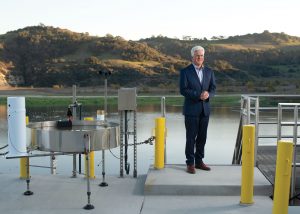
Daniel Ferons
General Manager of Santa Margarita Water District
“We import most of our water, and a quarter of our water supply is recycled water. We do have our own groundwater basin here—the San Juan Creek Basin. But unlike the Orange County Groundwater Basin, which is 500,000 acre-feet, ours is about 25,000 acre-feet. And it’s high in salt, iron, and manganese, so you have to treat it. So just the scale and scope of ours is totally different. But that doesn’t make it less important. It does make it more expensive to use.”
“We came together with the City of San Juan Capistrano in 2021, so we now have a local treatment plant. And we just broke ground on our Ranch Water Filtration Plant. We want to get to 30 percent of our drinking water supply being local water, so that in an all-out emergency—the San Andreas Fault goes and we can’t import water—people can still shower, cook, we can keep the fire hydrants working, and those kinds of things.”
“If you were to look at how much water we used in the ’90s, we’ve added 60,000 people but we use less water today. Our water conservation efforts over time have been very important. We work with customers to help them find and fix leaks, educating them about being smart about their irrigation practices.”

Joone Kim-Lopez
General Manager and CEO of Moulton Niguel Water District
“Today, 25 percent of our water demand is met with recycled water, which is quite a high number in comparison to other water agencies in the state. We focus on efficiency, and offer a number of different rebates to customers (such as for turf removal and high-efficiency fixtures).”
“We’re always looking at different avenues and exploring options for additional supply. We’ve invested jointly in service reservoirs, and we’ve also worked with northern agencies on being able to access the groundwater basin in times of emergency. One of the exciting things we’re doing right now is looking into direct potable reuse, basically treated recycled water for drinking purposes.”
“What keeps us going is the people. We’re data-driven and people-focused. We have an outstanding organization of employees who are truly dedicated to service.”
“In water, everything moves very slowly. But times of crisis force change. And we need to modernize. What we used to do worked well for a long time. But the challenges of today and the future are not what we had planned for. So that means we have to pivot, be more nimble, and embrace the world of new ideas.”

Paul Cook
General Manager of Irvine Ranch Water District
“The main question I get is, ‘Do we have enough water?’ We’re in a really good position. We have a diversity of sources for our water. Half is local groundwater, 18 percent is imported, 28 percent is recycled water, and 4 percent is captured rainwater from Irvine Lake.”
“I love to brag about our recycling program. Most of our sewage goes to our two recycling plants, where it’s treated and used for outdoor irrigation and other nondrinking uses. That’s why even in a drought, we can keep our service area so green. But we’ve put up signs to let people know, ‘Hey it’s OK—we’re using recycled, nonpotable water.’ ”
“Our customers are very efficient. We don’t like to use the word conserve—that to me is cutting back to the point that it’s painful. But they use water wisely. Our rate structure and outreach programs encourage efficiency. It sounds kind of weird to say, but we don’t want people to buy too much of our product. We’re a government agency and we’re providing a service. It’s expensive to buy imported water, so if we can avoid that we can pass those savings on.”
“The runoff from irrigation goes down San Diego Creek and into (our district’s) San Joaquin Marsh. There, it’s treated naturally; pollutants such as nitrogen are removed by the plants so that the water can safely flow into Upper Newport Bay and not cause algae blooms.”
